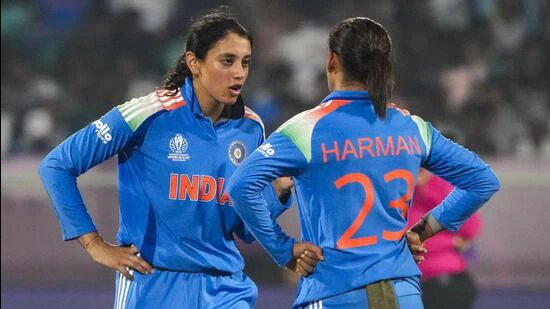Visakhapatnam: Two defeats on the trot, a strategy under scrutiny and a team looking a tad unsure of its most trusted formula – it’s not the situation India would have expected to be in at the midway stage of the World Cup.
You could tell from the faces of skipper Harmanpreet Kaur and deputy Smriti Mandhana during the last few overs against Australia that the mood in the Indian camp is about to become grim.
And understandably so. The side that looked buoyant after two wins to start with suddenly has a cloud of uncertainty hovering over it. India finished the Vizag leg with two consecutive losses, staring at uncomfortable questions at a stage when they should have staked a stronger claim for a semi-final berth.
The sticky situation they find themselves in can be troubling not just because of the points table but the timing too. This is probably the worst stage in a World Cup to second guess team combination and strategy. As other contenders strengthen claims for a top four spot, the co-hosts have been backed into a corner, searching for better balance in the side.
The World Cup is rarely the stage to experiment. It is a time for clarity, about what works the best with Plan B and C too ready if the original approach does not click.
With three group stage games still to go, however, it may not be too late for India to course correct.
Having lost to South Africa and holders Australia in Visakhapatnam, India will need to quickly decide their best combination before facing two more formidable sides in England and New Zealand. They are also yet to play Bangladesh.
The main area under review will be their five-bowler strategy after both SA and the Aussies chased down targets. It is likely that the Indian management will reconsider its ploy of prioritising batting depth that has limited the bowling options in crunch situations.
No team enjoys the luxury of Australia in batting or bowling depth. However, England and South Africa have been able to find that balance in this World Cup by using six or seven bowling options.
India currently go with one pacer, one pace-bowling allrounder, one left-arm spinner, and two off-spinners who can bat. Harmanpreet often dons the sixth bowler’s role. They also can use Pratika Rawal’s off-spin, but she hasn’t bowled.
India’s decision to stretch the batting till No.9 has reaped results with all-rounders Sneh Rana, Deepti Sharma and Amanjot Kaur all contributing. Perhaps it is time to bring in a specialist bowler, despite how tempting the assurance of a long batting line-up looks. One disadvantage though has been a lack of hard-hitters besides Richa Ghosh with Harmanpreet nowhere near her best.
“We’ll sit and discuss,” Harmanpreet said on Sunday. “This combination has given us a lot of success. Two bad games are not going to make a big difference for us, but going forward there are a lot of things we need to work out.”
Head coach Amol Muzumdar seemed to suggest that some changes were due.
“After this game we’ll have a look at it. I’m sure the team management will have a proper discussion about this and then we’ll take a right call as we approach the next game.” India’s next play England at Indore on October 19.
After the loss to SA, the team held a long discussion and identified reducing dot-ball percentage as a priority.
Muzumdar admitted that India have struggled to finish games despite strong starts. Against South Africa, they recovered after a poor start, but let the game slip in the final overs after posting a fighting 251.
Against Australia, despite a great start, they lost six wickets for 36 runs in 30 deliveries and were all out with seven balls left.
Perhaps the team balance issue could have been addressed after South Africa chased down the target.
Persisting with the same XI against Australia looked a vote of confidence for the existing plans, but the hosts can’t afford another slip up.
Flexibility then could be the key. Muzumdar suggested that he would not like to tinker much with the batting line-up though they failed to defend 330 against Australia. Poor fielding and catching too have hurt India.
Having already faced Australia in the pre-World Cup ODI series, India had ample opportunity to refine their plans. Ahead of the England test on what is expected to be a high-scoring Indore pitch, India have over a week to relax and reassess to bounce back with a stronger show.
The World Cup is rarely forgiving for those seeking answers mid tournament, that too when the gap between the top teams is closing. Hesitation can also prove costly.
